View in other NatureServe Network Field Guides
NatureServe
Montana
Utah
Wyoming
Idaho
Wisconsin
British Columbia
South Carolina
Yukon
California
New York
River Jewelwing - Calopteryx aequabilis
Native Species
Global Rank:
G5
State Rank:
S4
(see State Rank Reason below)
Agency Status
USFWS:
USFS:
BLM:
External Links
State Rank Reason (see State Rank above)
It has a widespread, but spotty distribution in Montana and seems to have a preferred habitat not found in streams in many areas of the state.
- Details on Status Ranking and Review
River Jewelwing (Calopteryx aequabilis) Conservation Status Review
Review Date = 09/18/2008
Population Size
ScoreU - Unknown
CommentUnknown.
Range Extent
ScoreE - 5,000-20,000 km squared (about 2,000-8,000 square miles)
Comment5000-20,000km (2,000-8,000square miles)
Area of Occupancy
Comment200-1000 km (125-620 miles) linear river
Length of Occupancy
ScoreLD - 200-1,000 km (about 125-620 miles)
Long-term Trend
ScoreE - Relatively Stable (±25% change)
Short-term Trend
ScoreE - Stable. Population, range, area occupied, and/or number or condition of occurrences unchanged or remaining within ±10% fluctuation
CommentDocumenting many additional populations since 2006
Threats
ScoreG - Slightly threatened. Threats, while recognizable, are of low severity, or affecting only a small portion of the population or area.
CommentClimate Change, increasing stream temperatures and lower snowpack could seriously impact the habitat that this speces exists in
SeverityLow - Low but nontrivial reduction of species population or reversible degradation or reduction of habitat in area affected, with recovery expected in 10-50 years.
ScopeLow - 5-20% of total population or area affected
CommentNo threats identified
ImmediacyLow - Threat is likely to be operational within 5-20 years.
CommentNo threats identified
Intrinsic Vulnerability
ScoreC - Not Intrinsically Vulnerable. Species matures quickly, reproduces frequently, and/or has high fecundity such that populations recover quickly (< 5 years or 2 generations) from decreases in abundance; or species has high dispersal capability such that extirpated populations soon become reestablished through natural recolonization (unaided by humans).
Environmental Specificity
ScoreC - Moderate. Generalist. Broad-scale or diverse (general) habitat(s) or other abiotic and/or biotic factors are used or required by the species but some key requirements are scarce in the generalized range of the species within the area of interest.
General Description
This is a large damselfly about 1 ¾ to 2 ¼ inches long (45 to 52 mm). The body is robust, especially in the females. The color is an unmistakable iridescent green or blue. The outer third of the wing is black. Flight can look erratic with the black tipped wings, as they are weak but graceful flyers.
Diagnostic Characteristics
The color is an unmistakable iridescent green or blue. The outer third of the wing is black.
Species Range
Montana Range
Range Descriptions
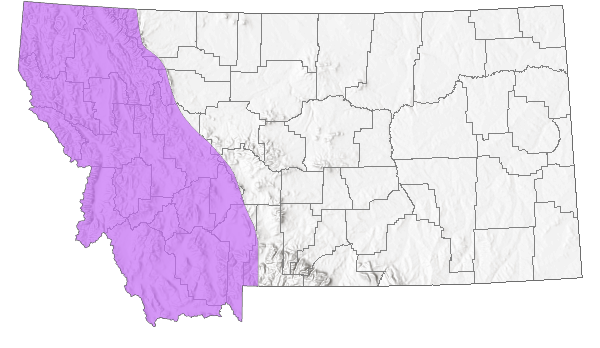
 Native
Native
Range Comments
Widespread across the mid-northern states of the US and soutern Canada provineces.This damselfly is found from southern British Columbia to Nova Scotia and south to New Jersey, Colorado, and Washington.
In Montana it is found infrequently in the lower elevation areas of the state. It was known only from western Montana (Miller and Gustafson 1996), until recently when it has been reported in spring-influenced, flowing streams in the northeastern part of the state (Stagliano 2007, Hendricks, Lenard and Stagliano 2012) and the southeastern corner of the state (Kohler, unpublished data 2012.
Observations in Montana Natural Heritage Program Database
Number of Observations: 59
(Click on the following maps and charts to see full sized version)
Map Help and Descriptions
Relative Density
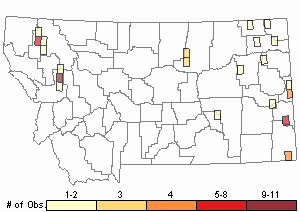
Recency
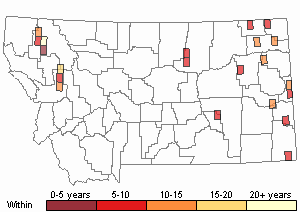

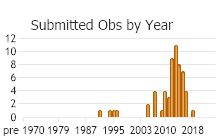
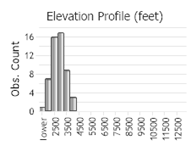 (Observations spanning multiple months or years are excluded from time charts)
(Observations spanning multiple months or years are excluded from time charts)
Habitat
The River Jewelwing is found in swift and rocky forested clear streams and rivers with shade and patchy sunlight. Optimum habitats have sufficient submergent vegetation present (Nikula et al. 2002, Acorn 2004, Paulson 2009). However, they have also recently been found along in perennially flowing spring creeks in eastern Montana (Stagliano 2007).
National Vegetation Classification System Groups Associated with this Species
Wetland and Riparian
Riparian and Wetland Forest
Riparian Shrubland
Food Habits
Larvae feed on a wide variety of aquatic insects, such as mosquito larvae, other aquatic fly larvae, mayfly larvae, and freshwater shrimp.
Adult- This damselfly will eat almost any soft-bodied flying insect including mosquitoes, flies, small moths, mayflies, and flying ants or termites.
Reproductive Characteristics
Male River Jewelwings can patrol longs flights along the shoreline, but more often defend territories of open water with submerged aquatic vegetation from other males with short circular flights. When a female flies near, males perform courtship flights where they fly fairly stationary in front of the female alternating their front and back wing beats. After copulation, the female backs down the stem of an aquatic plant until she is a foot or more underwater, and lays her eggs in the stem of the plant. She then floats or swims to the surface and flies away (Nikula et al. 2002, Acorn 2004, Paulson 2009). The eggs hatch in 18 to 30 days and the naiads take 2 to 3 years to mature.
Stewardship Responsibility
References
- Literature Cited AboveLegend:
 View Online Publication
View Online Publication Acorn, J. 2004. Damselflies of Alberta: flying neon toothpicks in grass. Edmonton, Alberta: University of Alberta Press. 156 pp.
Acorn, J. 2004. Damselflies of Alberta: flying neon toothpicks in grass. Edmonton, Alberta: University of Alberta Press. 156 pp. Nikula, B., J. Sones, D.W. Stokes, and L.Q. Stokes. 2002. Stokes beginner's guide to dragonflies and damselflies. Boston: Little, Brown. 159 pp.
Nikula, B., J. Sones, D.W. Stokes, and L.Q. Stokes. 2002. Stokes beginner's guide to dragonflies and damselflies. Boston: Little, Brown. 159 pp. Paulson, D.R. 2009. Dragonflies and Damselflies of the West. Princeton University Press, Princeton. 535 pp.
Paulson, D.R. 2009. Dragonflies and Damselflies of the West. Princeton University Press, Princeton. 535 pp. Stagliano, D.M. 2007. Freshwater conservation measures for the Northern Great Plains Steppe ecoregion of Montana. Helena, MT: Montana Natural Heritage Program. 36 pp + Appendices
Stagliano, D.M. 2007. Freshwater conservation measures for the Northern Great Plains Steppe ecoregion of Montana. Helena, MT: Montana Natural Heritage Program. 36 pp + Appendices
- Additional ReferencesLegend:
 View Online Publication
View Online Publication
Do you know of a citation we're missing? Dunkle, S.W. 2000. Dragonflies through binoculars: A field guide to dragonflies of North America. New York, NY. Oxford University Press. 266 pp.
Dunkle, S.W. 2000. Dragonflies through binoculars: A field guide to dragonflies of North America. New York, NY. Oxford University Press. 266 pp. Gillespie, D.M. 1966. Population studies of four species of mollusks in the Madison River, Yellowstone National Park. Ph.D. Dissertation. Bozeman, Montana: Montana State University. 43 p.
Gillespie, D.M. 1966. Population studies of four species of mollusks in the Madison River, Yellowstone National Park. Ph.D. Dissertation. Bozeman, Montana: Montana State University. 43 p. Heaton, J.R. 1966. The benthos and drift fauna of a riffle in the Madison River, Yellowstone National Park. Ph.D. Dissertation. Bozeman, Montana: Montana State University. 59 p.
Heaton, J.R. 1966. The benthos and drift fauna of a riffle in the Madison River, Yellowstone National Park. Ph.D. Dissertation. Bozeman, Montana: Montana State University. 59 p. Hendricks, P., S. Lenard, D.M. Stagliano, and B.A. Maxell. 2013. Baseline nongame wildlife surveys on the Fort Peck Indian Reservation. Report to the Assiniboine and Sioux Tribes of the Fort Peck Indian Reservation. Montana Natural Heritage Program, Helena, MT. 83 p.
Hendricks, P., S. Lenard, D.M. Stagliano, and B.A. Maxell. 2013. Baseline nongame wildlife surveys on the Fort Peck Indian Reservation. Report to the Assiniboine and Sioux Tribes of the Fort Peck Indian Reservation. Montana Natural Heritage Program, Helena, MT. 83 p.
- Web Search Engines for Articles on "River Jewelwing"
- Additional Sources of Information Related to "Insects"





